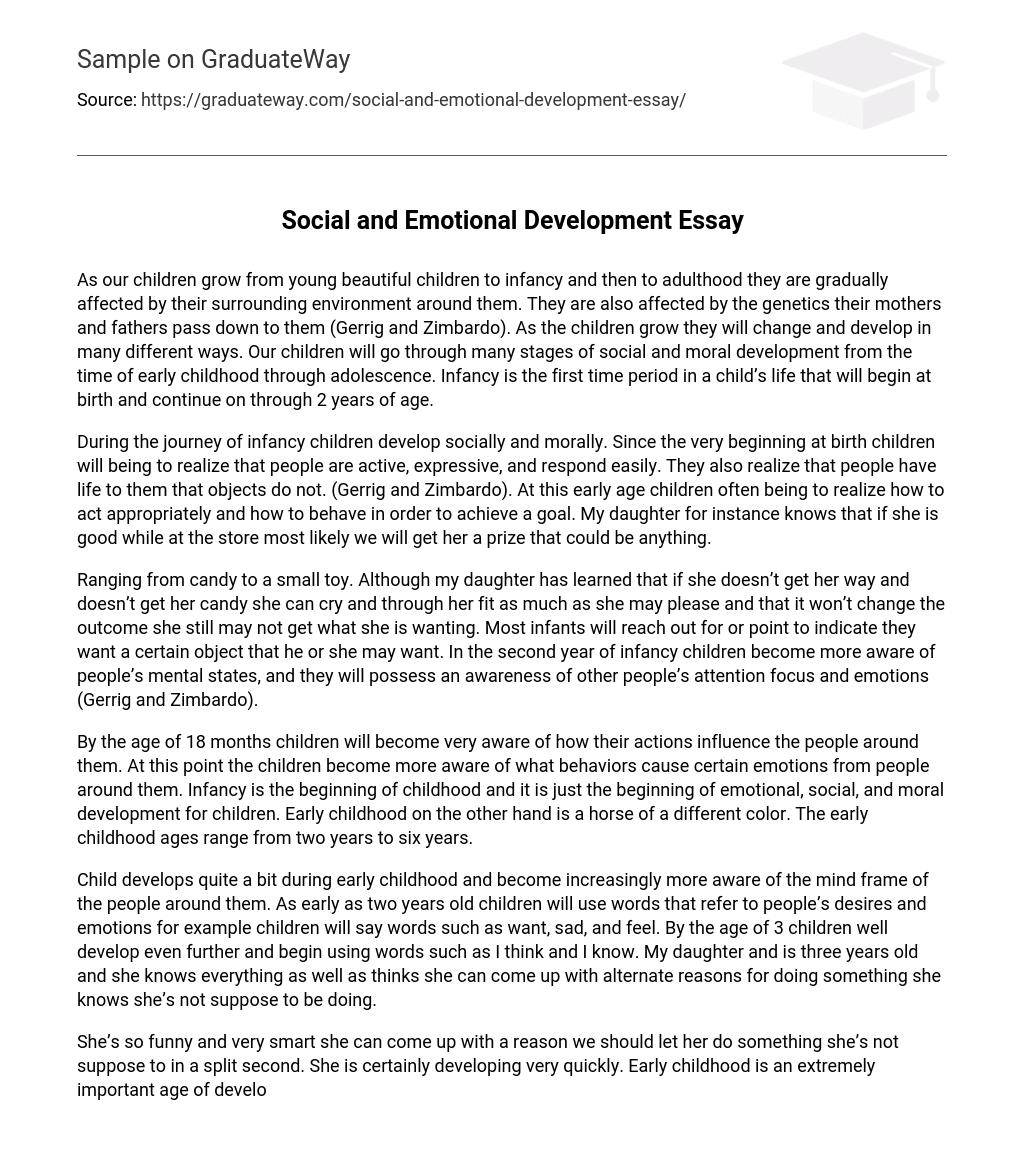From birth until the age of two, our children go through various stages of social and moral development influenced by their environment and genetic traits inherited from their parents (Gerrig and Zimbardo). These stages extend throughout childhood to adolescence.
During infancy, children experience social and moral development. From birth, they start to recognize that people are active, expressive, and responsive compared to objects (Gerrig and Zimbardo). In this early stage, children frequently learn appropriate behavior and strategies for achieving their goals. For example, my daughter comprehends that behaving well at the store increases the likelihood of receiving a prize of her choice.
As my daughter grows, she is learning that tantrums and tears are not always effective in getting what she wants. In the beginning, babies typically communicate their desires by reaching out or pointing at objects they desire. However, as children enter their second year of infancy, they start to become more attuned to people’s thoughts and emotions (Gerrig and Zimbardo).
By 18 months of age, children develop a strong understanding of how their actions affect others, becoming more conscious of the behaviors that elicit specific reactions from those around them. Infancy marks the initial stage of childhood, thereby initiating the emotional, social, and moral development in children. In contrast, early childhood encompasses the period between two to six years old when an entirely different phase begins.
During early childhood, children experience significant developmental changes and gain a deeper understanding of the thoughts and emotions of others. Starting as young as two years old, they begin to use words that convey desires and feelings, such as “want,” “sad,” and “feel.” By the age of three, their language skills further progress as they incorporate phrases like “I think” and “I know.” This progress is evident in my own three-year-old daughter who confidently believes she possesses all knowledge and can even devise alternative explanations for her actions, despite knowing she shouldn’t engage in them.
She possesses a remarkable sense of humor and intelligence, enabling her to swiftly justify engaging in activities she shouldn’t. Undoubtedly, she is undergoing rapid development. The early childhood stage, lasting until approximately ages 4 or 5, plays a crucial role in a child’s development as they begin comprehending false beliefs and recognizing that situations can result in others holding different beliefs than their own. This phase is characterized by emotional growth. Middle childhood encompasses children aged six to ten.
During this stage, children in the age group become more aware of a person’s mental state. They become more observant of others’ behavior and understand that actions may not always reflect thoughts and feelings (Emotional Development). Furthermore, they develop a deeper understanding of the complexities of the mind and emotions. Early adolescence, encompassing ages ten through fourteen, is when children start displaying empathy towards others’ emotions.
In early adolescence, children experience increased introspection and gain the capacity to understand others’ emotions and thoughts. They start considering the perspectives of others instead of being solely self-focused. Late adolescence encompasses ages fourteen through eighteen and is characterized by rapid growth and the acquisition of adult responsibilities.
Children have gained a substantial amount of knowledge through personal experiences, allowing them to think and feel independently. The remarkable growth and development of children is truly impressive. While children learn at different paces, they all go through these distinct stages. However, some may progress through these stages faster than others. At the age of three, my daughter often argues with me because she believes she knows better or thinks she does.
Unfortunately, informing her of her errors is not always well-received. However, she is improving and becoming more cooperative. Whether it’s due to her remarkable intellect or some type of OCD, she displays extraordinary brilliance for a three-year-old. Once, I bought her a box with 48 crayons and she spent a whole hour carefully organizing them from the darkest to the lightest hue. It was truly amazing – unlike anything we had witnessed before. Additionally, she has an exceptional memory and can recall everything; tricking her is difficult.
Children are astonishing in the way they process information in their young minds. It never fails to leave me impressed. For more information on emotional development in infants, toddlers, and adolescence as well as a summary of emotional development during childhood, visit Emotional Development – Emotional Development in Infancy and Toddlerhood, Emotions and Early Relationships, Emotional Development During Adolescence, Summary – Emotional Development during Childhood. (Gerrig and Zimbardo. Psychology and Life. 16th edition. Boston. 2002)





